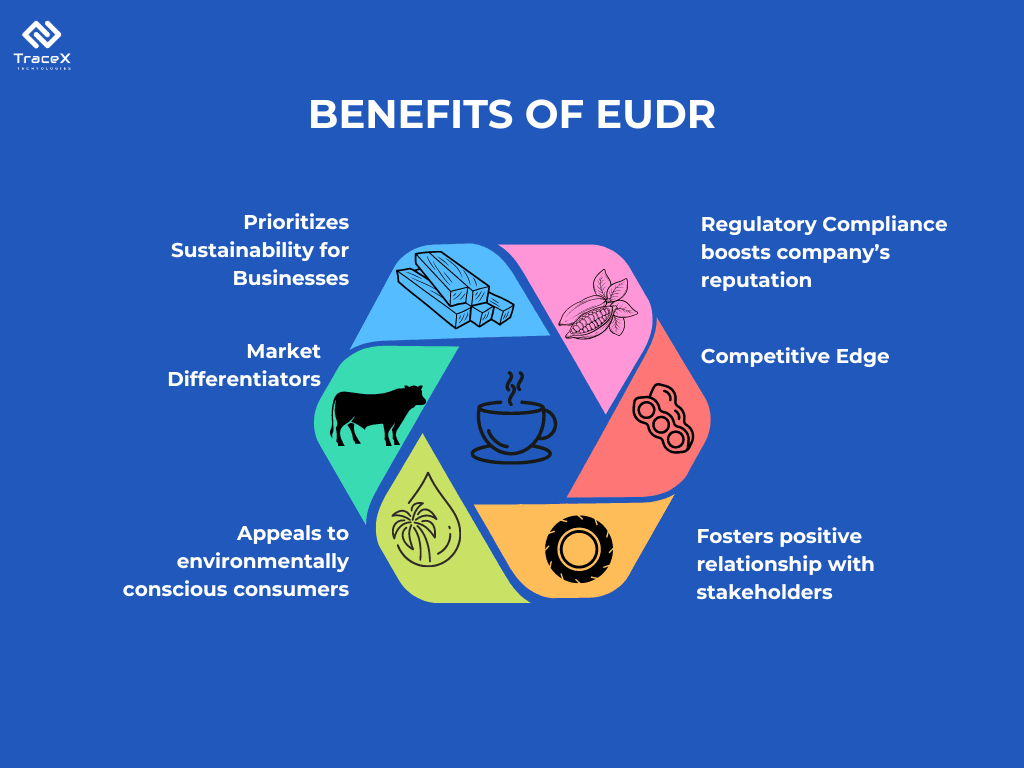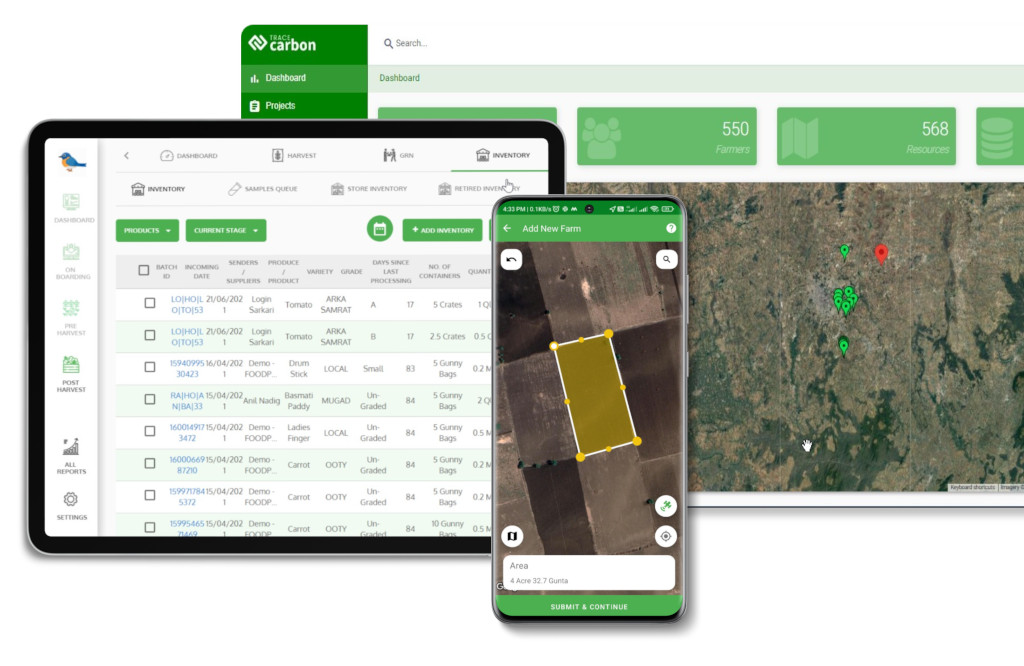Contact: +91 99725 24322 |
Menu
Menu
Quick summary: Wondering if the EU Deforestation Regulation (EUDR) applies to your business? Learn about the commodities covered, affected industries, and compliance requirements to ensure your supply chain remains deforestation-free and EU market-ready.

The EU Deforestation Regulation (EUDR) applies to businesses that import or export commodities like soy, palm oil, coffee, cocoa, wood, rubber, or beef into the EU market. If your company places these products on the EU market or exports them from the EU, you must comply with due diligence requirements, including geolocation mapping and deforestation-free verification. Products listed in Annex I of the regulation determine whether your business is subject to compliance.
According to WRI, almost 90% of the world’s forest loss is driven by the expansion of agriculture, thanks to growing consumer demand for commodities like coffee, cocoa, beef, soy, palm oil and timber.
Many businesses assume they are already compliant because they have sustainability certifications or ethical sourcing policies in place. Unfortunately, that’s not enough. The EUDR requires detailed proof that your products come from deforestation-free sources, backed by geo-mapped farm data and full supply chain transparency.
So, does EUDR apply to your business? Let’s break it down.
The EUDR covers seven key commodities: soy, palm oil, coffee, cocoa, wood, rubber, and beef—along with their derived products listed in Annex I. Only products made from or containing these commodities are subject to the regulation.
If you’re sourcing or selling cocoa or chocolate products, you must prove that your supply chain is deforestation-free. That means tracking cocoa farms, ensuring responsible land use, and providing geo-location data for every batch.
Palm oil has been a major driver of deforestation, so it’s no surprise that EUDR is cracking down. Whether it’s in food, cosmetics, or biofuels, businesses need to provide traceability from plantation to product—or risk losing EU market access.
Your morning cup of coffee now comes with a compliance requirement. Coffee companies must show proof that their beans weren’t grown on deforested land. Expect stricter supplier audits, satellite monitoring, and digital traceability mandates.
If you’re importing furniture, paper, or wooden goods, you’ll need to prove that your raw materials come from legal, sustainable sources—no illegal logging allowed!
If your business deals with soy for animal feed, rubber for manufacturing, or cattle for beef & leather, EUDR requires you to demonstrate a deforestation-free supply chain.
If your business touches any of these commodities, you need a solid traceability strategy—or you could face compliance risks, rejected shipments, and fines in the EU market.
The EUDR defines ‘operator’ as any natural or legal person engaged in a commercial activity who places relevant products on the market or exports them. Additionally, ‘traders’ are also required to comply with the Regulation. Traders are individuals or entities in the supply chain, other than operators, who make relevant products available on the market during their commercial activities.
The Regulation applies to both large companies and SMEs. However, SMEs are granted an extended deadline until 30 June 2026 to meet their obligations, and they will have simplified requirements compared to larger entities.
The specific list of products affected by the EU Deforestation Regulation (EUDR) is detailed in Annex I. Products not listed in Annex I are exempt from the Regulation’s requirements, even if they contain commodities covered by the Regulation. For example, soap, even if it contains palm oil, is not subject to the Regulation. Conversely, products listed in Annex I are only regulated if they contain or are made from the specified commodities. The prefix “ex” before an HS code in Annex I indicates that the product described is an “extract” from all items classified under that HS code. For example, HS code 9401 may cover various products, but only wooden seats are regulated. Products with HS codes not listed in Annex I, such as cars with leather seats or natural rubber tires, are also exempt, despite containing components derived from regulated commodities.
Understand Annex I, commodity thresholds, and how to decode HSN classifications.
Learn how to ensure your product listings are audit-ready and compliant.
Read our detailed blogs on
To prepare for the EUDR, businesses must map their supply chains, collect geolocation data, and verify product origin for deforestation-free compliance. Early adoption of traceability systems and due diligence workflows is critical to avoid penalties and ensure EU market access.
Who’s Affected?
What You Need to Do:
Who’s Affected?
What You Need to Do:
Who’s Affected?
What You Need to Do:
Who’s Affected?
What You Need to Do:
Who’s Affected?
What You Need to Do:
Who’s Affected?
What You Need to Do:
EUDR due diligence requires businesses to prove products are deforestation-free by collecting geolocation data, assessing risk, and submitting a Due Diligence Statement (DDS) via the EU TRACES system. Compliance applies before placing goods on the EU market.
So, what exactly does compliance look like?
Without proper verification, your supply chain could be flagged as high-risk, making it difficult to sell in EU markets.
Without geolocation data, you can’t prove compliance—no proof, no access to EU markets.
Without full traceability, businesses risk supply chain disruptions and non-compliance penalties.

EUDR compliance is more than just a checkbox—it’s a proof-based requirement that demands accurate, verifiable data on your supply chain. Many businesses assume they are compliant, only to face shipment delays, penalties, or loss of EU market access due to common mistakes. Let’s break down the biggest compliance pitfalls—and how you can avoid them.
Many businesses assume that Fairtrade, Rainforest Alliance, or Organic certifications are enough for EUDR compliance. Unfortunately, they aren’t.
✔ What EUDR Actually Requires:
Ensure your suppliers provide GPS coordinates of farms and integrate digital traceability tools to store and verify this data.
If you don’t know exactly where your raw materials come from, you’re at risk of non-compliance. Many businesses rely on middlemen, traders, or indirect suppliers, making it harder to track sourcing regions.
✔ What EUDR Actually Requires:
Use blockchain-powered traceability to connect with suppliers and ensure full visibility into your sourcing network.
A Nigerian firm leveraged TraceX’s solutions to enhance data accuracy, ensure EUDR compliance, and improve operational efficiency, reinforcing their commitment to quality and sustainable sourcing.
Ready to streamline compliance?
Still using paper records and spreadsheets? These outdated methods slow down audits, increase errors, and make verification difficult.
✔ What EUDR Actually Requires:
Switch to digital compliance dashboards that automatically track and store sourcing data, making audits quick and painless.
Many companies rely on self-reported supplier data, which can be inaccurate or incomplete. Without satellite monitoring and independent verification, you might unknowingly be sourcing from deforested land.
✔ What EUDR Actually Requires:
Integrate satellite-based compliance tools that provide real-time land-use insights, preventing non-compliant sourcing.
Navigating EUDR compliance can be complex, but with TraceX’s EUDR compliance platform, businesses can automate, verify, and streamline their compliance processes—ensuring smooth exports to the EU. Here’s how our blockchain-powered traceability system makes EUDR compliance seamless and stress-free.
EUDR requires proof that your raw materials come from deforestation-free land. Many businesses struggle with collecting, storing, and verifying this data.
✔ With TraceX:
Instant geo-verification ensures that your sourcing meets EUDR regulations—without the manual headaches.
EUDR mandates full traceability across your supply chain, including supplier identity, land legality, and documentation. Manual processes are error-prone and time-consuming.
✔ With TraceX:
• Digital supplier onboarding with built-in KYC and certification uploads
• Localized document collection and language support for regional compliance
• Unified supplier profiles linked to farm data, audit history, and sourcing records
Centralized onboarding creates a verifiable chain of custody—from farm to exporter—ensuring every supplier meets EUDR standards.
Risk analysis under EUDR must account for country benchmarks, land history, and supplier behavior. Businesses often lack scalable tools to assess or act on these risks.
✔ With TraceX:
• AI-driven scoring using satellite data, historical deforestation trends, and location benchmarks
• Real-time alerts for “high-risk” sources as per EU classification
• Smart mitigation suggestions like alternate sourcing, field audits, or geo-validation
Automated risk detection enables faster, smarter decision-making—reducing exposure and ensuring timely, compliant sourcing.
EUDR mandates a clear chain of custody, linking raw materials to finished goods. Traditional tracking methods often result in data gaps, errors, and inefficiencies.
✔ With TraceX:
Your entire supply chain is digitally documented, verifiable, and accessible in real-time for easy audits.
Without real-time digital records, businesses struggle to submit Due Diligence Statements (DDS) and meet compliance deadlines.
✔ With TraceX:
Reduce manual paperwork, eliminate reporting delays, and maintain 24/7 audit readiness.
Many companies operate on complex, legacy ERP systems (SAP S/4 HANA, Oracle, and Microsoft Dynamics) for inventory, supplier, and procurement management, creating integration challenges.
✔ With TraceX:
One unified view across your existing systems, ensuring compliance tracking doesn’t disrupt daily operations.
The EU Deforestation Regulation represents a significant step towards addressing global deforestation and promoting sustainable practices within supply chains. By understanding the EUDR scope and implementing effective compliance strategies, businesses can contribute to environmental conservation, enhance their market position, and navigate the complexities of the regulation.
As the EUDR continues to shape the landscape of global trade and sustainability, companies must embrace transparency, invest in technology, and collaborate with stakeholders to achieve meaningful impact. The path to compliance may present challenges, but it also offers opportunities for growth, innovation, and positive change in the fight against deforestation.
Discover how to stay EUDR-compliant with confidence:
Stay compliant, audit-ready, and future-proof—across your entire supply chain.
EUDR applies to companies importing, exporting, or trading forest-risk commodities like soy, palm oil, coffee, cocoa, rubber, beef, and wood within the EU market.
Both large and small businesses must comply, with enforcement dates set for December 30, 2025 (large companies) and June 30, 2026 (small enterprises).
Companies must conduct due diligence, trace product origins using geolocation data, and ensure deforestation-free sourcing through verified documentation and traceability platforms.
